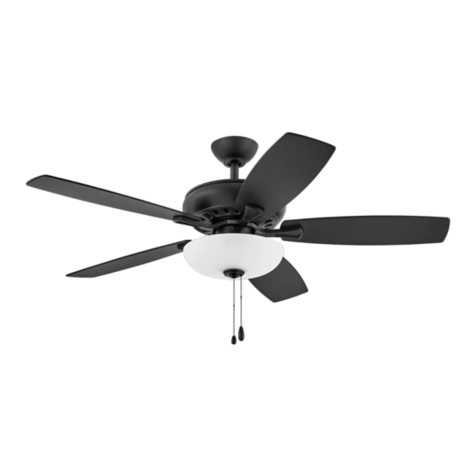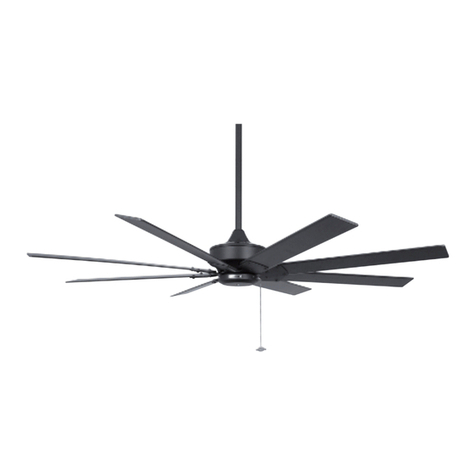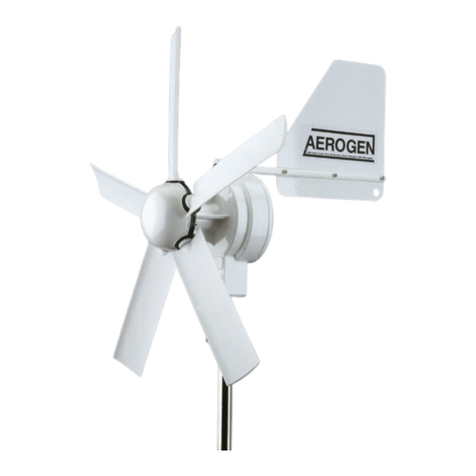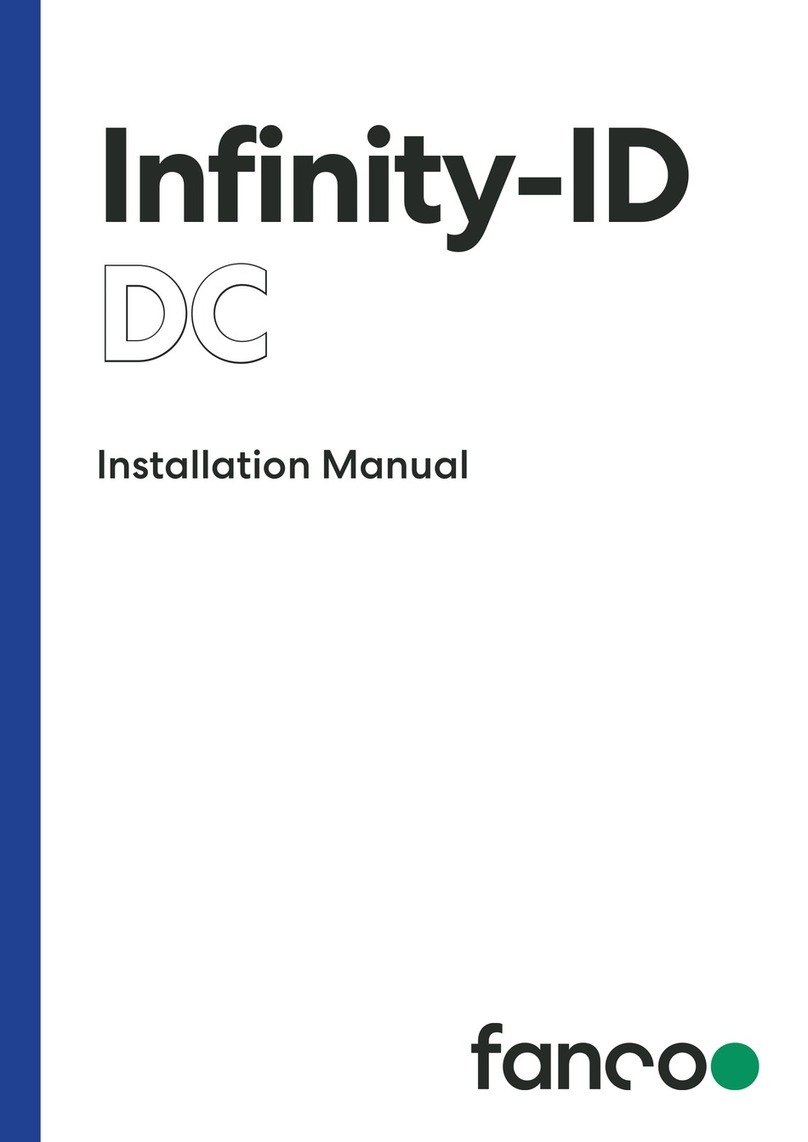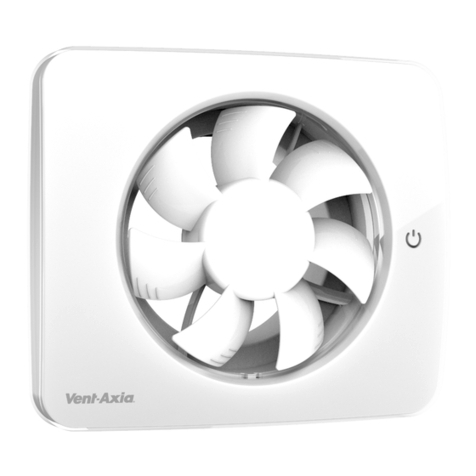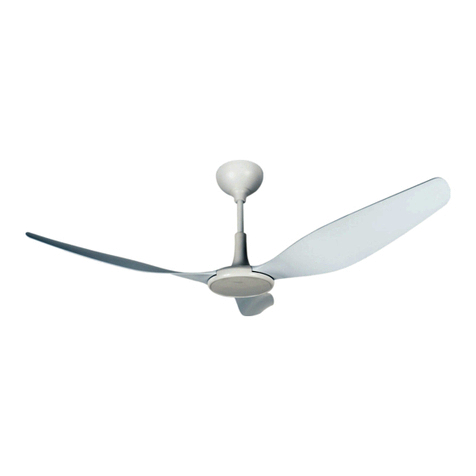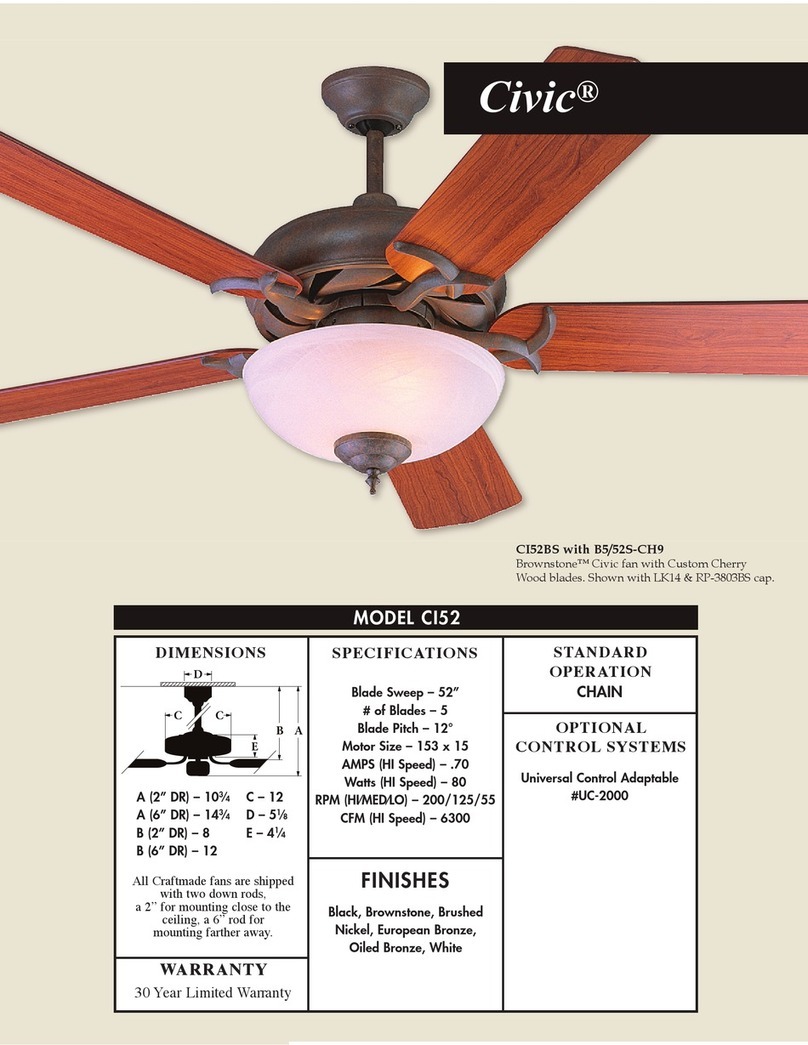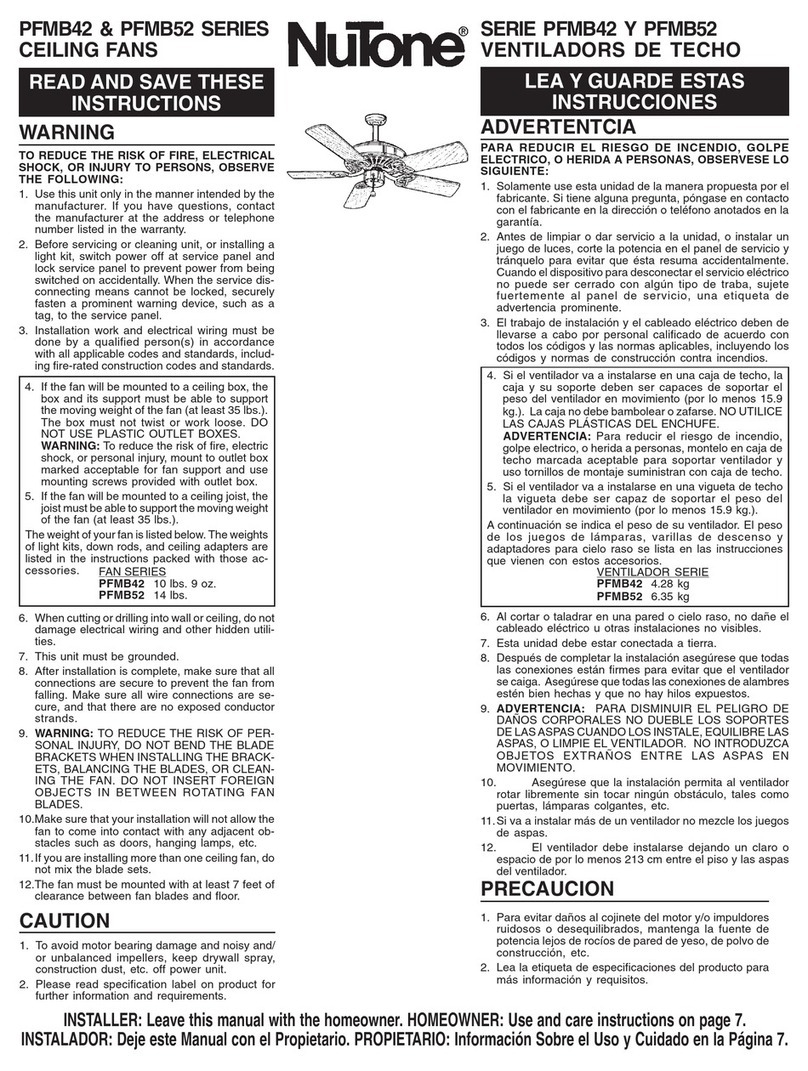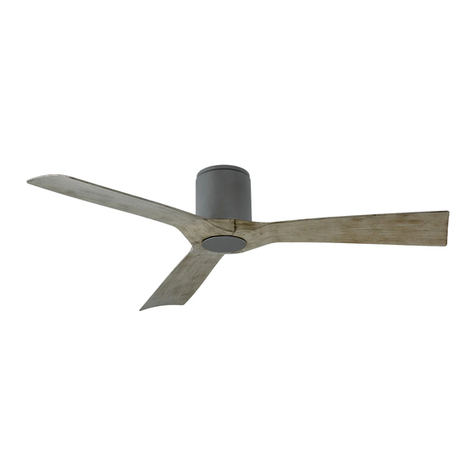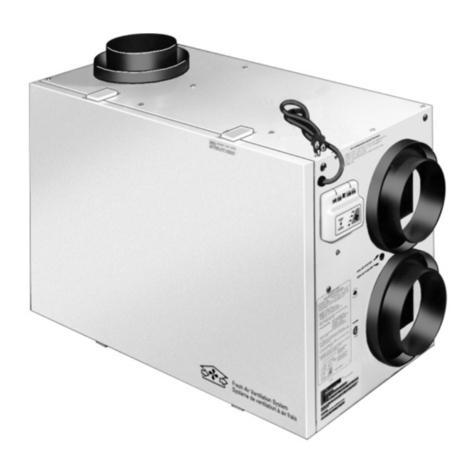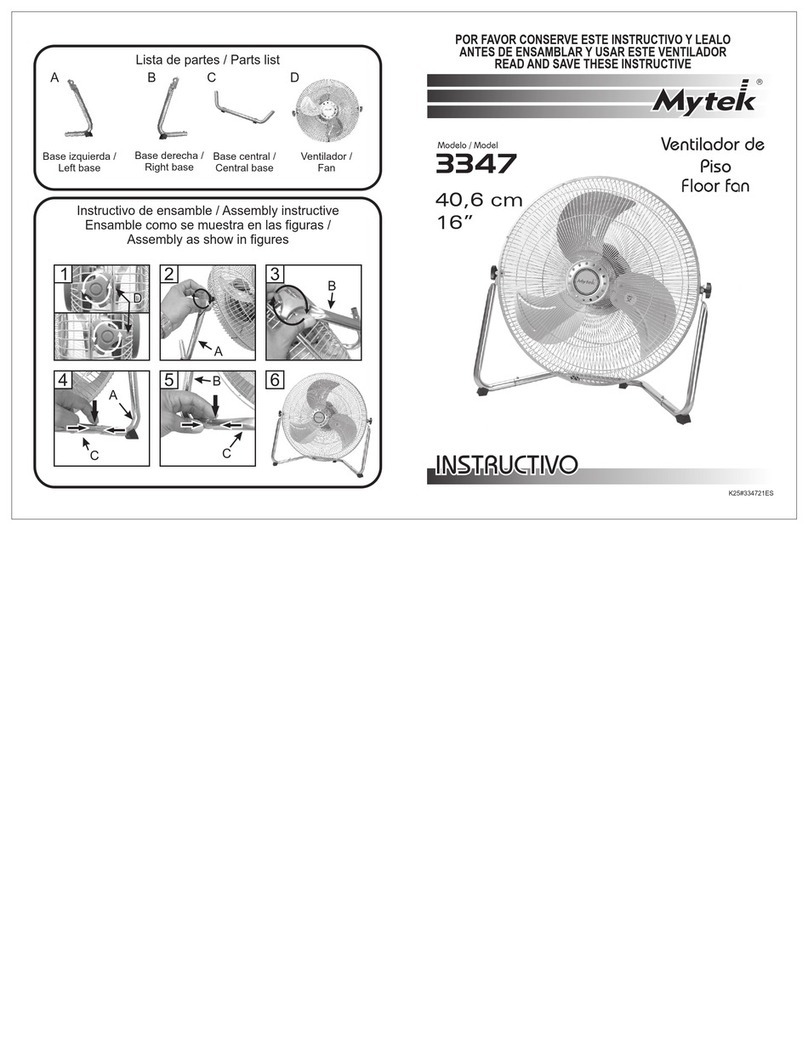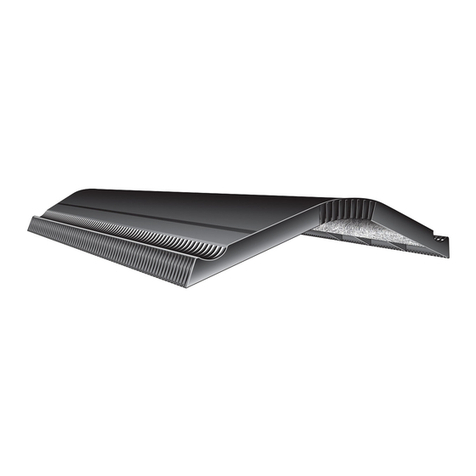Aerostar SkyStar User manual

Installation
and operation manual
SkyStar

1
Safety Rules ...................................................... ..............................................................................2
General information ....................................................................................................................... 3
Application and operating conditions ............................................................................................. 3
Transportation and lifting ................................................................................................................4
Warehousing ................................................................................................................................... 4
Plant design ................................................................................................................................... 4
Inspection side ................................................................................................................................ 4
Information and safety.................................................................................................................. 4
Contents of delivery ....................................................................................................................... 4
Identification of SkyStar components ............................................................................................. 5
Installation ..................................................................................................................................... 6
Connection ..................................................................................................................................... 6
Heating and Cooling Media Feeds .................................................................................................. 6
Water Connected Air-handling Component Installation ................................................................ 6
Water and Glycol Heat Exchangers ................................................................................................ 7
Direct Evaporators ..........................................................................................................................7
Steam humidification .....................................................................................................................7
Condensate Drainage .....................................................................................................................8
Electrical Equipment Wiring .......................................................................................................... 8
Wiring of motors .............................................................................................................................9
Electric heater wiring. ................................................................................................................... 10
Commissioning ............................................................................................................................. 11
Safety Measures ............................................................................................................................ 11
Inspection Prior to First Start-Up ................................................................................................... 11
Checking During the First Start-Up ............................................................................................... 13
Service Regulations ...................................................................................................................... 14
Unit Operation Screening Checks ................................................................................................. 14
Regular Inspections ..................................................................................................................... 14
Maintenance checks recommended by the Aerostar service for air handling units .................... 16
Warranty conditions..................................................................................................................... 19
Acceptance certificate.................................................................................................................. 20
Notes .............................................................................................................................................21

2
Safety Rules
Do not switch the air handling unit without grounding.
Before turning the ventilation unit all panels must be closed, and the cover are
in place and secured.
Before turning the ventilation unit its sections must be connected in accordance
with the installation instructions.
Before carrying out an internal inspection unit, make sure the power
supply of ventilation unit is turned off, there are no rotating parts.
Before opening the panel by turning off the unit and main switch, wait (1-2
min.), Until the fans stop.
Air handling unit can only switch on and switch off in ways specified in the device
data sheet.
Be careful when performing installation or repair of water heater -
the coolant temperature can reach 130 ° C!
If the unit is operated with the automation system is not coherent with the plant
manufacturer for the functionality, reliability and safety protection devices
responsible company that installed automation.
The moving parts in the units - a fan impeller, the lock of the bypass valve and plate
heat exchanger (if any). The removable service panels are locked and protected from
direct contact with moving parts. If the outputs of the fan section is not connected to
the air ducts or other sections, these outputs must be covered with a protective mesh.

3
General information
1. Suspended air handling units are manufactured in accordance with the Ukrainian and European
technical standards and regulations.
2. Skystar units must be installed and used only in accordance with this documentation.
3. For damage caused by improper use of the equipment, the manufacturer is not responsible, the
entire risk of the equipment accepts the buyer.
4. The installation and operating documentation must be available to maintenance personnel and
service organization. It is recommended to place it near the installation of ventilation and air-
conditioning.
5. When handling, installation, electrical connection, commissioning, and repair and maintenance of
equipment, you must follow applicable safety rules, regulations and generally accepted technical
rules. First of all, it is necessary to use personal protective equipment (gloves) because the
installation contains sharp edges and corners. All connected equipment must comply with
current standards and safety regulations.
6. Replacement and repair of individual system components, which could affect the safety and proper
operation of the equipment is strictly prohibited.
7. It is strongly recommended to read and strictly observe the instructions and recommendations
provided in the following sections before installation and use .
8. Installation and commissioning of the equipment in operation can only be carried out staff
specialized firm having approval from the manufacturer according to the applicable rules and
regulations.
9. Properly designed and installed ventilation system will not give effect, if it is not for the proper care.
10. After the installation , ventilation system must be checked, adjusted in accordance with the project
and in a totally proper and prepared for the operation of state commissioned to service personnel.
11. When checking must verify that the actual performance of the fan, heat output heaters specified in
the project
Note!
-The design of installations may be amended, without impairing its consumer
properties and not addressed in this guide.
Application and operating conditions
SkyStar units are designed for comfort ventilation and air conditioning in small spaces.
Available in various sizes in the flow range from 500 to 4700 m3/h,maximum fan pressure up
to 1000 Pa. The design is identical to the settings at their internal and external use. SkyStar
units are designed to supply air without solid, fibrous, sticky, aggressive, respectively
explosive impurities. The air must not contain substances that contribute to corrosion or
decomposition of zinc, steel or aluminum. Operating temperature range in the standard
version from -30 ° C to + 40 ° C.

4
SkyStar units are delivered to the customer or at the installation site in an assembled form,
or as separate units (sections and sectional modules). Installation / blocks placed on
transport pallets. When transporting the equipment needed to comply with the requirements
laid down in the passport of the air handling unit. It is necessary to monitor the installation
protruding elements (intake and discharge energy, electrical components, sensors) during
transportation. Be careful and cautious when lifting and laying.
Warehousing
Plants are placed on standard pallets are packed in a PE film and have a protective foam insert.
Storage is permitted on the premises:
- A maximum relative humidity not exceeding 85% non-condensing
- With ambient temperatures ranging from -30 ° C to + 40 ° C
- Prevent the entry of dust, gases and corrosive materials evaporation or other chemicals that
promote corrosion of structural parts and optional equipment.
Plant design
The installation consists of independent sections, joined together during assembly. Sections
are selected depending on the purpose and scope of the installation.
The design of installation is modular, panel, frameless. The housing consists of two steel sheets
between which is laid a layer of non-combustible mineral wool. The outer side of the body is
painted with Polyester coating. Along the perimeter of the compound body panels insulated
with silicone sealant. Bottom installation closes a removable service panel.
Inspection side
SkyStar design allows to choose the direction of connection to an external power source
and service accesses. Side is determined relative to the air flow direction, right or left.
Information and safety
SkyStar Plants and separate sections are equipped with identification icons that indicate the
function of equipment, wiring diagrams, energy supply and drainage. Warning of the danger
of touching the rotating parts placed on removable service panels, which are equipped with a
sticker warning symbol. Separate junction boxes and service panels covering electric, fitted
with label with warning symbol.
Information about the place of supply:
-heat transfer fluids in the heat exchanger;
-refrigerant in the evaporator;
Contents of delivery
SkyStar unit included:
-Maintenance
-Pasport
-Connecting kit (if the installation is delivered unassembled)
-Automation kit(optional)
-Accessories according to invoice.
Transportation and lifting

5
Identification of SkyStar components
Each section is equipped with an identification label and icon (located on the outer part of
the service section).
Information about the place
of supply:
-heat transfer agent
-refrigerant( evaporator).
Information about the place of the output:
-heat transfer agent
-refrigerant( evaporator)
Information about the direction of airflow in the installation
Service panel electrical heating section, separate junction boxes and
service panels covering electric, equipped with a warning sticker
Warning of the danger of touching the rotating parts placed on removable
service panels, which are equipped with a sticker warning symbol

6
Installation
Before installing the wiring is carried out as follows:
- Contents of delivery
- Delivery condition
- Free running of the rotating parts
- Control of the electrical network parameters
- Control of temperature and pressure of connected energy carriers, and their
compliance with the specified parameters of the unit.
Connection
A rubber seal is attached to the contact surface of the connecting walls. Sections are
connected with each other via corners and are fixed by bolts or studs and secured with
nuts M8 appropriate size.
It is necessary to ensure free access to the removable side panel
Heating and Cooling Media Feeds
All media feeds are connected to the outer side of the air-handling unit. The internal
interconnection is made during production in the factory. The corresponding
connection points are marked with labels
Water Connected Air-handling Component Installation
Recommendations on water quality for heat exchangers that operate using low pressure hot
water and chilled water:
A good water quality – e.g. salt and lime-free drinking water – increases the lifetime and
efficiency of the heat exchanger.
Check the limiting values shown in the table annually to prevent damage to the hydraulic
system and its components.
If necessary inhibitors must be added.
Note: These limiting values are only basic information about the water quality and do not
form any basis for a guarantee!

7
RIGHT LEFT
The lay-out of the openings can be selected according to the mixing set version and overall
dimensions. After connecting the water heat exchangers (heaters and coolers, including mixing
sets) to the distributing piping, it is necessary to pressurize (flush with water) and vent the
entire circuit, including the heat exchanger, and then to perform leak-tightness checks of all
pipe joints and of the exchanger itself (including checking the interior of the water exchanger
section). The manufacturer does not provide any guarantee covering any damage resulting
from liquid leakage from leaky joints or damaged exchangers.
Direct Evaporators
Direct evaporators must be connected by a specialized contractor authorized to
install refrigerating equipments. The direct evaporators are filled with nitrogen in the production
factory.
Steam humidification
For a detailed description of the installation, commissioning and prescribed inspections of the
steam humidification section, refer to the separate manual which is a part of the
accompanying documentation of the GlobalStar air-handling unit. When installing the steam
humidification section, observe the following recommendations:
Water and Glycol Heat Exchangers
The connections of heating and cooling media feeds must be performed so that no forces
arising from the dilatation and weight of feeding pipes and fittings will be transferred to the air-
handling unit. The corresponding connection points are marked with labels on the unit side
panel (heating water inlet, heating water outlet, coolant inlet, coolant outlet). As standard,
water heater exchangers are equipped with air selfventing 1/2“ TACO valves, which are situated
on top sides of both headers. Connecting fittings of sections with covered feeds must be
insulated and suitable grommets or sealing must be used to seal the passages through the
unit‘s casing. Heating or cooling media can be led to the heat exchanger through the lower
panel (universal) or through removable side panels (depending on the air-handling assembly,
respectively if it is enabled by the adjacent sections and service access

8
Air ducts led through cold areas must be insulated to avoid condensation. The steam
humidification assembly must be situated in a non-freezing area. The steam generator can be
noisy (switching of solenoid valves). Therefore, it is advisable to install it away from quiet areas
100 °C hot and heavily mineralized water is drained from the steam humidifier.
Condensate Drainage
Cooling, plate heat exchanger and steam humidification sections are equipped with stainless
condensate draining trays which terminate in an outlet for the condensate draining kit
connection. The siphon height depends on the total pressure of the fan, and ensures its proper
functioning. The type of condensate draining kit must be designed in the course of the air-
handling unit calculation. The condensate draining piping must end in a free atmosphere, i.e. it
must not end directly in the closed sewerage system. Before operating the air-handling unit or
after being out of operation for a longer period, it is necessary to fill the siphon via the plastic
plug with water.
The air-handling unit can also be equipped with a siphon with a disconnecting trap and a ball
valve (only negative pressure sections). This type of siphon need not be filled with water before
putting it into operation. If there is a risk of freezing, it is necessary to insulate the siphon and
condensate draining piping, respectively keep the ambient temperature above freezing point,
e.g. with an electric heating cable!
Electrical Equipment Wiring
The external connection of the internal electrical equipment of the air-handling unit can be
made via wiring the terminal boxes which are situated on the outer side of the air-handling unit
(the service side according to the designer‘s specification). The internal electrical equipment of
the air-handling unit has already been connected to the terminals of these wiring terminal
boxes. The wiring and installation of the system elements must be performed by qualified
professionals authorized to perform wiring of the given type of device. The wiring must be
performed in accordance with directives and standards of the state of installation, and in
accordance with the Installation and Operating Instructions of individual pieces of equipment
(frequency converters, pressure and temperature sensors, etc). Before putting the air-handling
unit into operation, a wiring inspection must be performed.

9
Before starting the wiring, check the following:
Conformity of the power supply parameters with the data on the type plate of the connected
section.
Cross-sections of connecting cables.
Wiring of motors
The motors connection must be performed in accordance with directives and standards of the
state of installation.
Warning: When performing any maintenance or repairs, the device must always
be disconnected from the power supply!
The motors are connected in the factory to the wiring terminal boxes situated on the external
casing of the fan sections. As standard, they are designed for a power supply of 3x 400 V / 50 Hz.
The service switch (delivered as an optional accessory separately) is not installed on the unit. The
service switch connection must be performed in accordance with directives and standards of the
state of installation, and in accordance with the Installation and Operating Instructions.
The service switch (delivered as an optional accessory) serves to disconnect the fan from the
power supply and from voltage. It prevents unintentional start-up and presence of voltage when
performing maintenance. This switch is not a substitute for the main or emergency switches.

10
Electric heater wiring
L1(1), L2(2), L3(3),PE,
- clamps of first power supply of electric heater. 3f-400V/50Hz
L1(4), L2(5), L3(6),PE,
- clamps of second power supply of electric heater. 3f-400V/50Hz
Errors
Main connections
Control connections
PE

11
Commissioning
The air-handling unit may be commissioned only by a properly qualified person.
Prior to first start-up of the air-handling unit, an inspection of the wiring of all
connected components of the air-handling unit must be performed by a qualified technician.
Safety Measures
The sections which can generate some injury hazards (electric shock, rotating parts, etc.) or
connection points (heating water inlets/outlets, air flow direction, etc.) are always labelled with
warning or information labels.
It is forbidden to start the fans of the air-handling unit if the panels are open or removed. The
hazard of trapping by movable parts is indicated by a label situated on the service door of the
air-handling unit. Service doors must always be closed during air-handling unit operation and
the lockable closure of the fan chambers must be locked with a key to prevent unauthorised
access.
Before starting any work on the fan section, the main switch must always be turned off
and secured to avoid accidental starting of the motor during service work on the fan section.
When emptying the heat exchanger, the water temperature must be below +60 °C.
The connecting piping of the heater must be insulated so its surface temperature will not
exceed +60 °C.
It is forbidden to remove the service panel of the electric heater if energized, or to change
the factory settings of the safety thermostat.
It is forbidden to operate the electric heater without the outlet air temperature control and
without ensuring the steady flow of transported air.
Controlled run-down of the fans must be ensured upon the gas heater section shut-down to
avoid the exchanger overheating, and simultaneously, the outlet air temperature behind the
gas heater, respectively ambient temperature of the burner, must not exceed 40 °C.
After being set by the expert, the parameters of the gas heater must stay unchanged to
maintain safe and trouble-free operation.
Inspection Prior to First Start-Up
General Checks
The service panels are provided with hinges and external closures. The closure simultaneously
serves as a handle. A special tool – a wrench – is needed to open/close the closure.
Check alignment of the air-handling unit. Check whether all components of the air-handling unit
are installed and connected to the air distributing ducting.
Check whether all cooling and heating circuits are connected, and whether energy media are
available.
Check whether all electrical appliances are connected.
Check whether all condensate draining kits are connected.
Check whether all components are installed and connected

12
Electric Wiring
Check the proper wiring of all individual electrical components of the air-handling unit
according to the corresponding wiring diagrams.
Filter Sections
Check the condition of filters.
Check the fixation of filters.
Check the settings of differential pressure sensors
Water and Glycol Heater Sections
Check the condition of the heat-exchange surface.
Check the condition of the inlet and outlet piping.
Check the condition of the mixing set.
Check the condition, connection and installation of antifreeze protection components.
Electric heater Section
Check the condition of the heating coils.
Check the connection of the heating coils
Check the connection of the emergency and operating thermostats.
Sections of water/Glycol heaters, Direct evaporators
Check the condition of the heat-exchange surface. Check the condition of the inlet and outlet piping.
Check the connection of the condensate drainage. Check the connection and
elements of the cooling circuit. Check the condition of the drop eliminator dampers.
Plate Heat Exchanger Section
Check the condition of the exchanger vanes.
Check the bypass damper functionality.
Check the drop eliminator condition.
Check the connection of the condensate drainage.
Gas Heater Section
Check the connection of the condensate drainage.
Check the wiring and functionality of the sensors and thermostats.
Check the gas burner connection.
Check the air-venting of the gas distribution system.
Check the gas-flue connection.
Check the bypass damper functionality
Fan Section
Check the fan impeller for intactness and free rotation.
Check the tightening of the Taper-Lock collets.
Check the tightening of the screw joints of the fan assembly.
Check the protective covers for integrity and mounting
Check the fan impeller, inlet and outlet for cleanliness and foreign
objects

13
Until the air-handling system is adjusted, the air-handling unit can only be put into operation
when the regulating damper in the airhandling unit inlet is closed. Operating the air-handling
unit while the air-handling system is misadjusted can cause motor overloading and permanent
damage. If the second stage of filtering is included in the air-handling unit, it is advisable to run
the testing operation with the second stage filter inserts removed.
Checking During the First Start-Up
Check the proper direction of the impeller rotation following the direction of the arrow on
the impeller or fan casing.
Check the proper direction of the rotary heat exchanger rotation following the direction of
the arrow on the rotor situated under
the service panel.
Check the input current of connected equipment (it must not exceed the maximum
permissible value stated on the rating plate).
Check the proper direction of the rotary heat exchanger rotation following the direction of
the arrow on the rotor (from the service panel side always upwards) and free rotation
without dragging.
After 5 minutes of operation, stop the air-handling unit and check the temperature of
bearings and the tension of belts (belt-driven fans only). This check may only be performed if
the fan is switched off!
Check the water level in the condensate draining kit. If the water has been sucked off, it will
be necessary to increase the height of the siphon.
Check the mounting of the filters
During the testing operation, it is necessary to check the air-handling unit for unusual noises
and excessive vibrations. The testing operation must last at least 30 minutes. After the test
operation has finished, the air-handling unit must be inspected. Pay special attention to filters
and check them for damage, proper functioning of the condensate draining kit. If the unit
vibrates too much, it is necessary to check again the fan assembly and perform vibration
intensity measuring, if necessary. If vibration intensity of the fan assembly with an overhung
impeller) exceeds 2.8 mm/s, measured at the motor bearing shield on the impeller side, the
fan must be checked and balanced by professional staff. During the testing operation it is
necessary to adjust (regulate) the entire airhandling system. Before putting the air-handling
unit into permanent operation, it is recommended to replace or regenerate the filter inserts.

14
Service Regulations
Before putting the air-handling device into permanent operation, the supplier
(installing company) in collaboration with the designer must issue service regulations in
accordance with local legal regulations.
We recommend including the following in these service regulations:
Air-handling device assembly description, its intended use and a description of its activities in all
operating modes.
Description of all safety and protective elements and their functioning.
Health protection principles, safety and operating rules to be observed when operating the
air-handling device.
Requirements for operating staff qualifications and training, a nomenclature list of
personnel authorized to operate the airhandling device.
Detailed emergency and accident instructions to be followed by the operating staff.
Operating particularities during different climatic conditions (e.g. summer or winter operation).
Inspection, checking and maintenance schedule, including a list of checking steps, and their
recording
Records of operating staff training, operation, inspections and cleaning of the rotary
heat exchanger (subject to guarantee validity).
Unit Operation Screening Checks
The operating staff checking activities must be focused on the following:
The air-handling unit operation and functioning; leak tightness of connections, inspection doors
and service panels; temperature of energy media and transported air; sensors indicating
fouling of filters.
The condition and operation of systems associated with the air-handling unit, and of which
proper functioning is needed for proper operation of the air-handling unit as well as for
operation of the entire air-handling system.
These are:
Electric wiring
VO water heater system - circuit, pump operation and water filters (also in SUMX)
Cooling system
Sanitary installation - condensate drainage
Gas heater system
Regular Inspections
The user will determine the intervals for regular inspections of the air-handling unit according to
the operating conditions, however, at least once in three months. Within the framework of the
inspection, check the following:

15
Overall Check
Clean all parts of the air-handling unit:
Min. 1× per year or more frequently, if needed (recommended cleaning solution – 10 parts of a
dish washing cleaner, 45 parts of Isopropanol, 45 parts of water – pH 5–9, do not use cleaners
containing active chlorine). Max. 50 °C when steam cleaning equipment is used.
When high-pressure cleaning equipment is used, there is a risk of paint damage, especially in the
elbows
Don’t use brushes or similar abrasive tools and cleaners
First, probe on a little surface area
Use the same technique on the entire surface area to prevent differences in colour in some areas
Fan Inspection
Check the fan operation (strange noise and excessive vibrations of the unit) and, if needed,
balance the fan, refer to the section Unit First Start Inspection.
Check the impeller for cleanliness.
Check the tightening of the Taper-Lock threaded pins
Check the impeller for integrity and free rotation
Check the assembly screw connections for tightening
Check the silent-blocks for condition (damage)
Check the fan assembly elastic sleeves
Check the motor and fan bearings in the fan case.
Filter Replacement
Different types of filter mounting are used depending on the air-handling unit size, filter type
and filtration class. When replacing filter inserts, always check the condition of the sealing; if
damaged, replace the sealing with a new one. If checking or replacing the filters, follow these
procedures:
The filters can be removed by pulling the frame edge out and then realising the sheet steel
retaining clamps. The replacement filter can be installed in the reverse procedure: Carefully bend
(without permanent distortion) both edges of the vertical frame, install the clamps and place all
the filters between the bars, first the lower row then the upper row, until they are completely
seated. It is advisable to perform regular inspections of the filters, especially if high air humidity is
present or if it fluctuatesthrough the day. Unsuitably low pressure loss read on the manometer
can indicate frame distortion. If this happens, a physical check of the filters is recommended
Spare Filter Inserts
A complete set of filter inserts can be ordered. Specification of the filter type (bag, compact,
insert, or grease/metal filter), air-handling unit size and filtration class will do. There is no need to
specify the types of individual filter inserts of the filter.

16
Checking the Exchangers (Heaters, Coolers)
Be very careful when cleaning the exchanger‘s vanes to avoid mechanical damage.
It is important to check the air-venting of the exchangers.
Permanently check the functionality of the condensate draining system (coolers).
Important note: If taking the exchanger out of operation during the winter season, the water
must be completely drained out of the exchanger, and possible water residuals must be
removed, e.g. by flushing the exchanger with pressurised air; or the exchanger must be filled
with a safe antifreeze solution of water and glycol. The water residuals can freeze in the
exchanger and damage the copper pipes.
Steam Generator Check
All prescribed checks are included in the Installation Instructions attached to the steam
generator. Please follow these instructions, especially the following:
First 5 hours of operation: check the water conductivity (min. 5 refills per water exchange cycle,
sparking and max. current checking); check the cylinders for condition (water leakage) and
operation; check the tightening of electrical connections.
Every three months: check the steam generator operation (number of water refilling switching per
cycle) and the condition of the cylinders (water leakage, condition of electrodes and inner casing
of the cylinder).
Yearly or every 2500 service hours: replace the boiling cylinders; check the condition and shape of
hoses; check the sealing of the distributing tubes inside the chamber; check the tightening of
electrical connections.
Warning: Attention-electrical equipment! The steam generator cylinder can be hot. In case of
water leakage, hazard of burning and/ or electric shock exists! The intervals of inspections and
service life of parts can vary depending on the water quality and operating conditions.
Checking the Electric Heater
Check the heating coils for fouling; vacuum the heating coils if necessary. Check the functionality
of the safety thermostats.
Checking the Plate Heat Exchangers
Check the plate heat exchanger for fouling. Check the functionality of the condensate drainage.
After completing the regular inspection of the air-handling unit, it is necessary to verify and
record its actual performance parameters.
Verification Measurements
Maintenance checks recommended by the Aerostar service for air handling units
Once a month:
1. Visual inspection of equipment, checking fixtures, fences and structures supply installation;
2. Check the power supply in phases (checking voltage imbalance, check for current
imbalances);

17
3. Monitoring the Status and cleaning (replacement) air filters;
4. Check the electric regulating and shutoff valves;
5. Monitoring and recording the state of automation;
6. Check the anti-vibration mounts;
7. The service water pump;
8. Check the operation of the drainage system and if necessary cleaning the drainage;
9. Monitor the belts;
10. Check the status of the heat exchanger;
Once a quarter:
11. Check the condition of the power and control circuits equipment, as necessary to produce
retightening;
12. Monitoring and debugging three-way valve water air heater;
13. Monitoring and debugging three-way valve water-cooling;
14. Bearing lubrication supply installation;
15. Check if necessary adjustment, equalization of the drive pulley and the pulleys of the fan;
16. Check if necessary adjustment, the parallelism of the shafts of the engine and the fan;
17. Checking and belt tension;
18. Check alignment and impeller shaft;
19. Removing plaque from the impeller;
20. Check the correct position of the crankcase protection belts;
21. Lift the depreciation of springs at the base of the fan motor;
22. Check the flexibility and strength fasteners;
Semi annually:
23. Dry cleaning drainage of condensate;
24. Monitor the water filter with stainless steel mesh for contamination;
Once a year:
25. Cleaning louvres;
26. Inspection of air ducts for leaks;
27. Chemical cleaning of the heat exchanger;
28. Washing and cleaning of the inner cavity of forced ventilation unit;
29. Planned seal the duct;
30. Revision bearing fan motors;
31. Verification of compliance instruments Bale;
32. Revision of the impeller handling unit;
33. Check the electric regulating and shutoff valves;
34. Maintenance of drainage siphons;
35. The service water pump.

Warranty conditions
The VENTSERVICE Limited Liability Company, hereinafter referred to as the Manufacturer,
manufactures the Unit in accordance with the requirements of Technical Specifications TU U
28.2-35851853-002:2013 and the design documentation and ensures that the Unit complies with
the requirements of technical documentation providing that the consumer observes the rules of
transportation, storage, installation, commissioning and operation during installation and
commissioning works performing by a specialized organization having a relevant manufacturer’s
permission. Warranty obligations are fulfilled under the conditions specified in paragraphs 9.1-3.3
During the warranty period the manufacturer is obliged to eliminate equipment malfunctions of the
Unit or its parts and components resulting from factory faults. The basis for consideration of claims
for fulfilment of warranty obligations is Claim. The procedure for filing and content of the Claim is
specified in section 9. The manufacturer decides whether the components or their defective parts
shall be replaced or whether they shall be repaired on site.
The executed warranty service does not increase the warranty period; the warranty on the replaced
parts will expire with the expiration of the warranty period of the Unit.
These warranty terms are valid for all agreement for purchase of Manufacturer’s Units, unless other
terms are specified in these agreements.
Warranty period
The unit warranty period is 36 months from the date of delivery of the equipment to the consumer,
but not more than 42 months from the date of production. The date of transfer of the equipment
to the consumer is the date of the expenditure invoice issue by the Distributor.
The service life of the unit is at least 10 years.
The following are not covered by the guarantee:
1. Parts of equipment and maintenance materials subject to normal physical wear (filter, fuses, etc.)
2. Unit damage, resulting from:
a) ingress of foreign objects or liquids;
b) natural phenomena;
environmental exposure;
c) animal activities;
d) unauthorized access to the assembly units and parts of the Unit by persons not authorized to
carry out the specified actions;
f) mechanical damage and breakage due to non-compliance with the installation and operation
instructions.
3. Various modifications, changes in the operation parameters, processing, repairs and replacement
of parts of the Unit performed without the consent of the Manufacturer or the Distributor.
4. Damage caused by idle time during the period of waiting for warranty service and any damage to
the Customer’s property, other than the Manufacturer’s Unit, will not be compensated.
18

Warranty services
1. Work under this warranty shall be performed within 14 days from the date of the claim
submission. This period shall be extended in exceptional cases, particularly in cases when more time
is required for delivery of parts, or if the service cannot be performed on site.
2. Parts dismantled from the Unit by service workers during the warranty repair and replaced with
new ones are the property of the Manufacturer.
3. Costs arising from unjustified claims or due to interruptions in service at the request of the
claimant shall be borne by the claimant. Repair services shall be evaluated in accordance with the
services rates established by the Distributor or the Manufacturer.
4. The Manufacturer has the right to refuse to perform warranty services or maintenance if the
customer delays payment for the equipment or for previous service work.
5. The Customer shall help the service workers when carrying out repair work on site by means of:
a) providing access to the Unit and to the relevant documents at the appropriate time.
b) ensuring protection of the service team and its property, as well as compliance with all health
and safety requirements on site.
c) creating conditions for instant commencement of work immediately upon the arrival of service
workers and performance of work without any obstacles.
d) providing free necessary assistance for work (for example, supplying elevators and free sources of
electricity).
6. The Customer is obliged to accept the completed warranty services immediately on their
fulfilment and to confirm it in writing in the certificate of completion, the copy of which he receives.
7. The warranty shall not be maintained in case the service has not been conducted in accordance
with the regulations for operation of this type of product.
Claims information
Acceptance of products shall be carried out by the consumer according to the “Instructions on the
procedure for quality acceptance of products for industrial purposes and consumer goods”.
Upon detection of a quality inconsistency, the consumer shall send a Claim to the Distributor, which
is the cause for resolving the issue of validity of the provided claim.
A list of Distributors and their contact information is available at www.aerostar-vent.com.
The Distributor shall be provided with written Claims. Claims may be submitted by fax or e-mail. The
Claim shall contain type, factory number, expenditure invoice number and Unit delivery date, as
well as Unit location, telephone numbers and full name of the person in charge.
The Claim shall also contain a description of installation problems, as well as the titles of the
damaged parts (if possible).
If the Customer violates the rules of transportation, acceptance, storage, installation and operation,
no quality claims are accepted.
19
Table of contents
